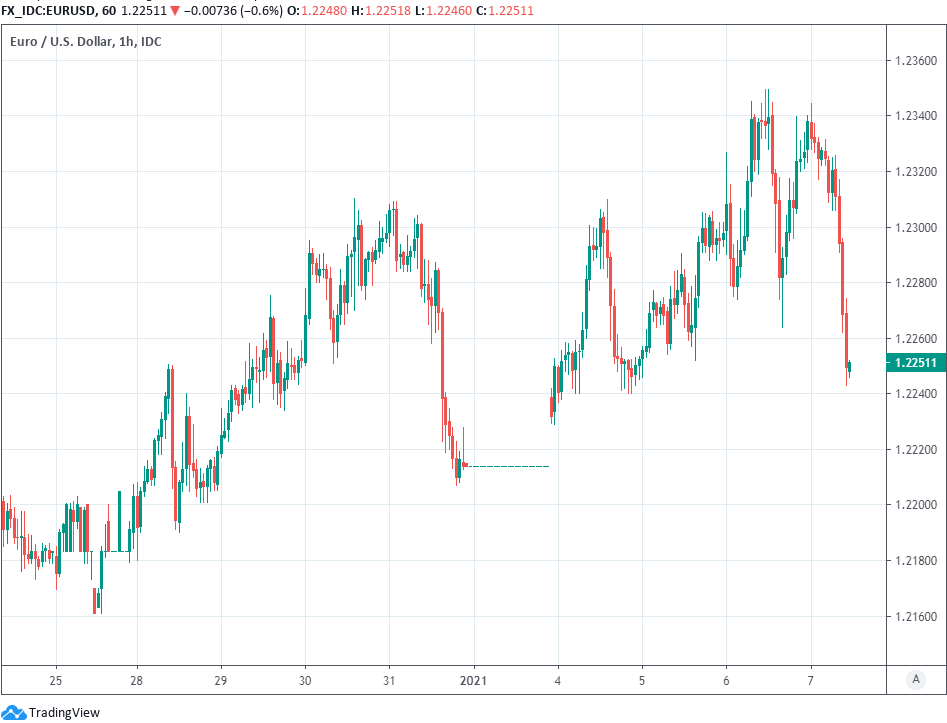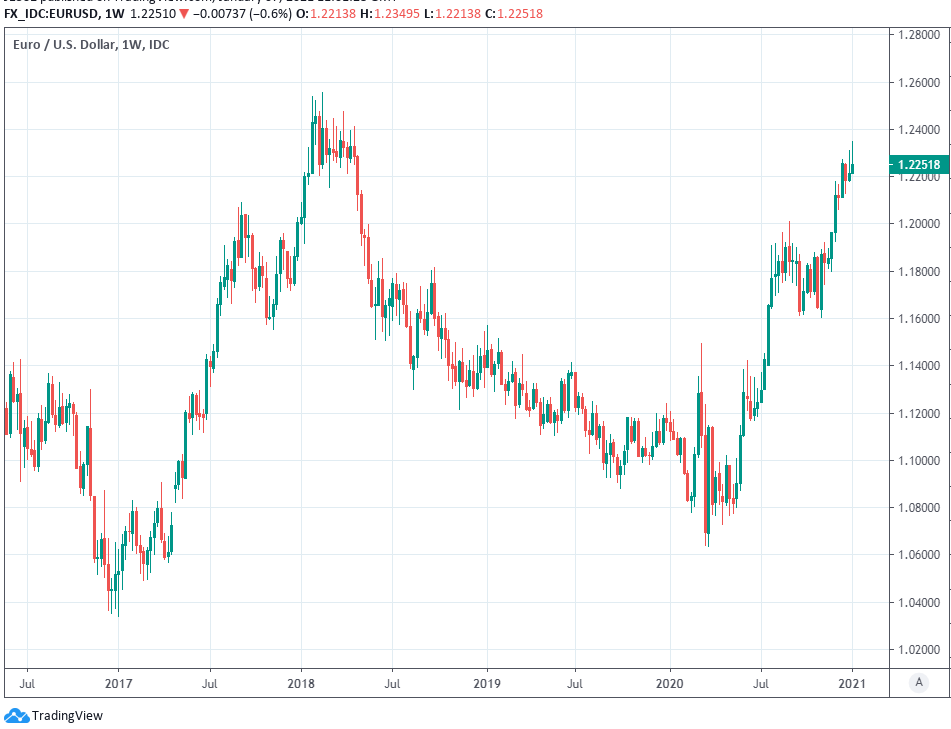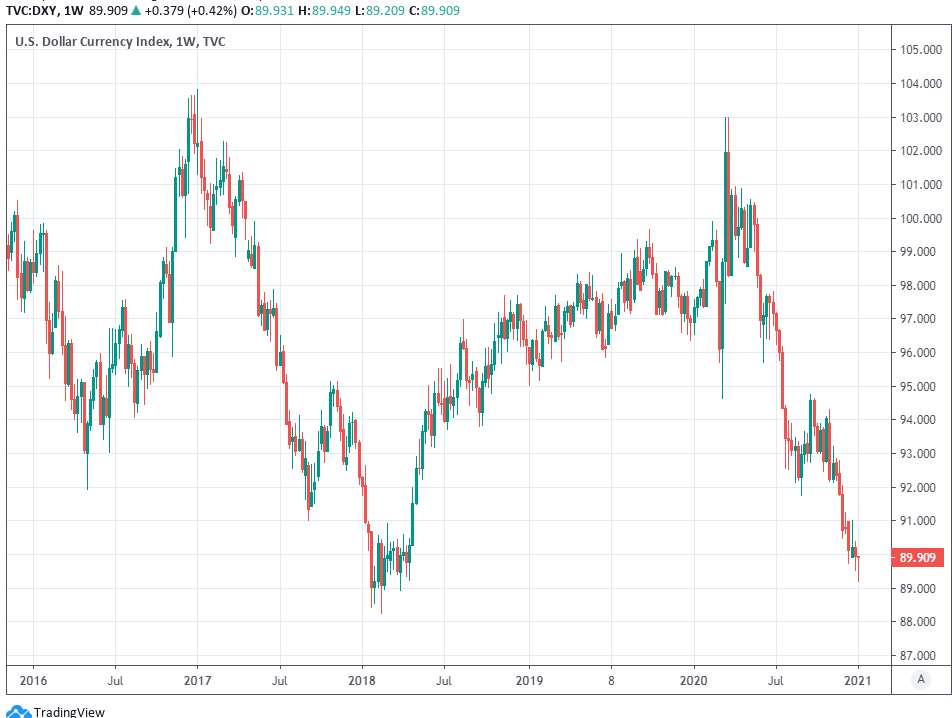Euro-Dollar Retreats after USD Steadies and Eurozone Data Disappoints
- Written by: James Skinner

Image © European Union - European Parliament, Reproduced Under CC Licensing.
- EUR/USD spot rate at time of writing: 1.2261
- Bank transfer rate (indicative guide): 1.1832-1.1918
- FX specialist providers (indicative guide): 1.2077-1.2175
- More information on FX specialist rates here
The Euro was in retreat from close to three-year highs against a steadier Dollar on Thursday after inflation and retail sales figures from the Eurozone disappointed the market, while investors weighed a shifting U.S. political landscape and disorder in Washington.
Europe's single currency got no respite from Thursday's losses when Eurostat said that inflation remained at a record low of -0.3% in December and that retail sales fell by -6.1% in the prior month of November.
Consensus suggested economists were looking for the consumer price index to rise to -0.2% and for sales to fall by only -3.5% in a month that saw many major European economies return to at least some form of lockdown.
Inflation declines were steepest in Greece, Ireland, Estonia and Germany respectively while sales fell the most in France and Belgium where restrictions on activity were imposed earlier and in a more severe form than elsewhere.
"The outlook for retail still seems difficult, with extensions of lockdowns and some countries even tightening restrictions again. The overall economic impact is still very fluid as announcements of new restrictions continue to be made, but it looks unlikely that 2021 will start with positive economic growth," says Bert Colijn, a senior economist at ING.

Above: Euro-to-Dollar rate shown at hourly intervals.
November's sales indicate the market may have underestimated the impact that renewed closures will have on the economy.
"It’s not hugely surprising that the measures to contain the virus midway through Q4 drove a significant drop in trade on a monthly basis. The divergence between countries, however, is startling. The headline decline was driven almost exclusively by an 18% m/m collapse in France, while the data elsewhere were more robust," says Claus Vistesen, chief Eurozone economist at Pantheon Macroeconomics. "The drag from energy inflation will soon fade, and we also think the core will edge higher in due course."
The prices data confirms that European Central Bank (ECB) policymakers are facing an uphill battle to return inflation to their target. Core inflation also remained unchanged, at 0.2%, for a fourth consecutive month at year-end after having fallen from 1.1% in early 2020. Both it and the main consumer price index are far below the "close to, but below 2%" target so will do little to put the ECB at ease with recent strength in the Euro.
{wbamp-hide start} {wbamp-hide end}{wbamp-show start}{wbamp-show end}
The ECB has cut its main interest rate to zero, pushed its deposit rate to -0.50% and has bought a still-growing share of the Eurozone bond market over the last five years in a bid to foster the faster GDP growth that's necessary for producing a sustainable 2% rate of inflation.
"The ECB is facing substantial challenges, with limited policy tools. The Strategy Review is supposed to come up with a plan, but we don't see easy solutions. It is also not clear which way it will affect the EUR, as ECB monetary policy easing tends to support the periphery and sometimes ends up supporting the EUR," says Athanasios Vamvakidis, head of FX strategy at BofA Global Research. "We are skeptical about substantial further EUR strength, particularly during a Eurozone recession that is more severe than in most of the rest of the world. The long EUR market position also makes it one of the most vulnerable G10 currencies to an overall market risk-off."

Above: Euro-to-Dollar rate shown at weekly intervals.
The core rate of inflation - which ignores volatile energy and food prices as well as a hanful of other items - has not been above 1.2% since the ECB unveiled its first quantitative easing programme in January 2015 and the bank is now running out of policy ammunition.
A near-10% 2020 rise in EUR/USD and a 2020 fall for GBP/EUR have lifted the trade-weighted Euro this last year while making imported goods cheaper, which risks further reducing inflation in 2021. Sterling, the Dollar and Chinese Yuan collectively account for more than half the trade-weighted Euro.
Various ECB officials have repeatedly sought to persuade the market out of buying the Euro in the way that they did last year, although often to no avail because EUR/USD gains have also reflected a U.S. Dollar sell-off that many analysts expect will continue in the year ahead.
The Dollar rose after violence flared in Washington when Congress confirmed electoral college votes for President Elect Joe Biden to take office on January 20, although stock markets and other risky assets also climbed while safe-haven government bonds were sold widely.
"Persistent negative Eurozone inflation means Eurozone real yields remain much higher than in the US. The implication is the fundamental uptrend in EUR/USD is intact," says Elias Haddad, a senior FX strategist at Commonwealth Bank of Australia. "In our view, a relief rally in USD will be brief and contained. Global economic growth prospects remain encouraging, USD is overvalued relative to the value implied by real two‑year interest rate differentials and there is no underlying demand."

Above: U.S. Dollar Index shown at weekly intervals.




